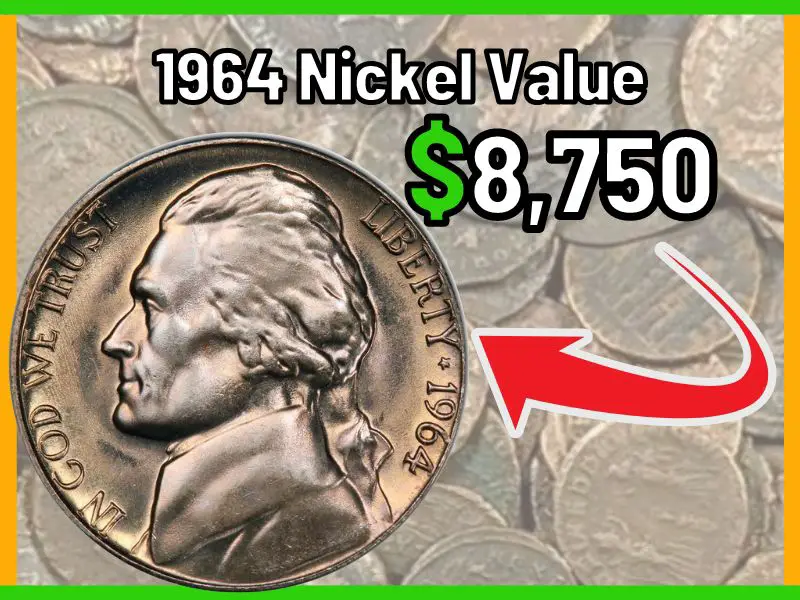
In today’s market, a 1964 nickel is worth 5 cents in circulated condition. But if you can get a rare, Uncirculated/mint condition coin, then you can get a good price as those can be worth as much as $250. An extremely rare 1964 nickel in the 1964 SMS variant can even be worth $8,750 in MS65.
Without a doubt, this coin is very valuable to any collector. Price and monetary value asides, what exactly makes this coin so unique? Keep reading this article to find out how much a 1964 nickel is worth and what makes it such a collectible.
1964 Nickel Identification Guide
1964 Nickel Specifications |
|
| Year Of Mintage | 1964 |
| Denomination/Face value | Five Cents |
| Alloy (metal) | 75% Copper, 25% Nickel |
| Weight | 5.00 g |
| Diameter | 21.21 mm |
| Edge type | Smooth (Plain) |
| Designer | Felix Schlag |
The 1964 Jefferson nickel had its big debut in 1938 after it replaced the Indian Head nickel.
Although it’s been over 100 years since its original debut, this coin is still being used in commerce till date.
The 1964 Jefferson nickel has the constituents of 75% copper and 25% nickel. This coin has had quite an interesting history.
History
As mentioned previously, the 1964 nickel, like most coins in United States history, is not devoid of its unique origin story. The first Jefferson coins were struck and released into circulation in 1938, after replacing the Buffalo nickel that ran for 25 years prior.
To get only the best bust imagery to grace the obverse (heads) of the coin, a design contest was held to celebrate and commemorate the third president of the United States and founding father, Thomas Jefferson.
This contest was open to “all American sculptors” and was held in 1937. Felix Oscar Schlag, an American sculptor (but initially from Germany), was crowned the winner of this competition. He received $1,000(which is about $17000 today).
At that time (the 1930s), nickel was important material, and it was being hoarded and redistributed towards the war efforts by the military. That’s why the United States Congress came up with a temporary measure of controlling the level of nickel supply towards coin production by substituting nickel with other materials like an alloy of copper, manganese, and silver to make Jefferson coins.
Then came 1964, and the Jefferson Nickel series made history when the US mints struck a record 1,000,000,000+ coins.
The mints wanted to use the nickel coins to make up for the shortage of silver coins in circulation due to another series of hoarding of silver in the 1960s. Unlike the earlier Jefferson nickels that were produced from the 1930s to the end of the 1950s, the 1964 series had a soft, sharp appearance because they used higher-quality dies.
In that same year, mint director Eva Adams took measures to prevent the coin collecting community’s hoarding as they were blamed for the shortages of coins in circulation. She removed mint marks from coins produced in Denver, and San Francisco even went as far as stopping the production of proofs. As a result, nickels dated 1965, ’66, and ’67 lack distinguishing mint marks.
This effort was misplaced as the hoarders were not responsible for the coin shortages. In fact, the growing popularity of vending machines, automatic tolls and other coin-accepting devices were the culprits for the coin shortage, and the mint factories were unprepared for their high usage.
Amongst all this chaos, the 1964 coin was unaffected, and this is because they were originally struck in the early part of 1965 before these aforementioned measures were taken. The 1965-D Jefferson nickel has the highest mintage of the entire series till date, and it’s the most common coin among the series.
1964 Nickel Features
The 1964 Jefferson nickel is a composite metal piece with a silver-like appearance. Regardless of its silvery appearance, it has zero silver content among its composite. It contains 75% copper and 25% nickel, weighing about 5 grams and has a diameter of 21.2 millimetres.
Obverse
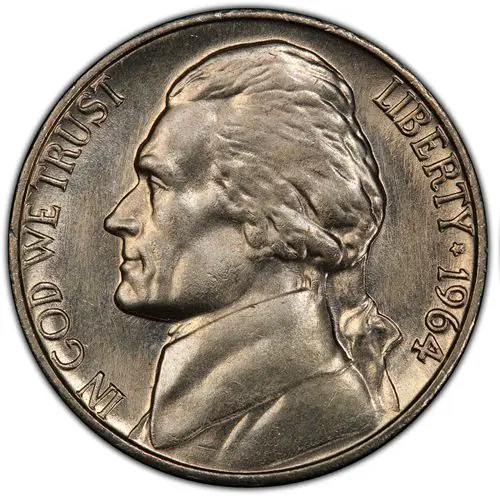
The obverse of the coin features a left-facing portrait of the third president of the United States, Thomas Jefferson. This portrait is placed in the centre and almost dominates the entirety of the coin’s obverse surface.
The inscription “IN GOD WE TRUST ” runs clockwise from Jefferson’s chest to his upper hairline on the left margin. On the right side, just behind Jefferson, is the 1964 date also running clockwise and the word liberty which is separated from the date by a five-point star.
Reverse
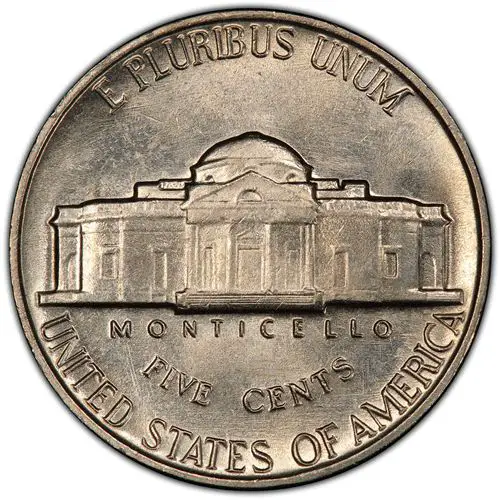
On the reverse (tails end) is Jefferson’s mansion in Charlottesville, Virginia, the Monticello.
Here’s a fun fact, Jefferson designed the mansion himself, following architectural principles and design patterns from Renaissance Italy and the name “Monticello” translates to “little mountain” in Italian.
The Monticello occupies the entire central part of the reverse, and the inscription “Monticello” is right below it.
On the upper margin is the famous Latin inscription “E PLURIBUS UNUM,” which stands for “out of many ones”. A slogan referring to the 50 states that make the United States a single nation.
1964 Nickel Series
1964 Nickel Quantity Minted |
||
| Year | Location | Minted |
| 1964 D Nickel | Denver | 3,799,071,500 |
| 1964 Penny No Mint Mark | Philadelphia | 2,648,575,000 |
| 1964 Proof Penny | Philadelphia | 3,950,762 |
The mint Of a coin is simply the state in which the coin was produced. These coins are distinguished by what is known as a mint mark (a letter that denotes its mint state). For example, there are more than three states where coins are struck in the United States.
There is Philadelphia (indicated by the letter P/no mint mark), San Francisco (S) and Denver (D), among others.
1964 D Nickel
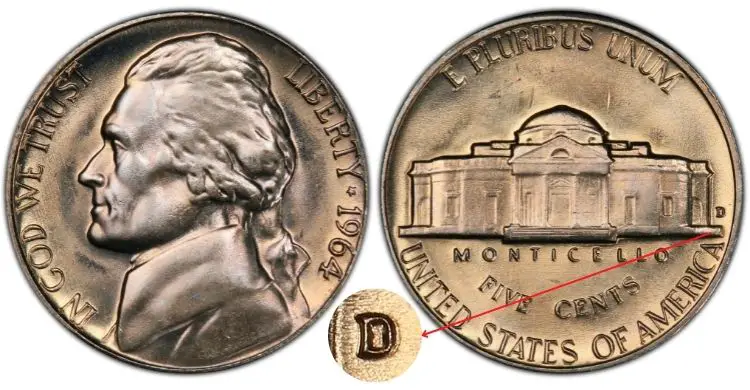
Denver was the major manufacturer of 1964 nickels, and that’s why 1964-D nickels are the most Jefferson nickels in circulation till date. They produced over 1 billion coins, setting a record. The D mint mark on your Denver coin can be found to the right of the Monticello on the reverse of the coin.
1964 No Mint Mark Nickel
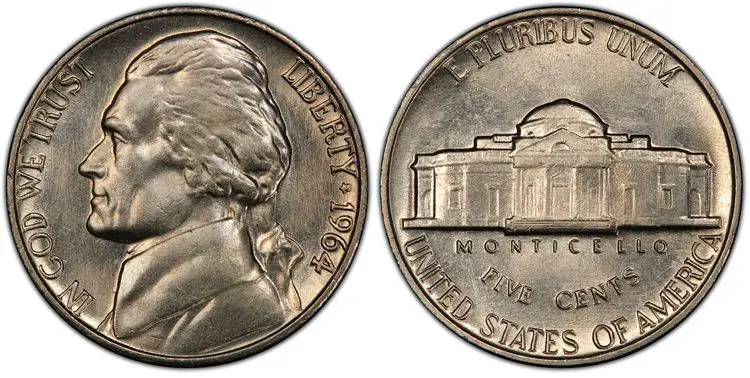
Philadelphia 1964 nickels also set a record 1 billion coins struck during the production of the vintage era Jefferson series.
There are so many in circulation that the grade condition determines the value of these coins.
1964 Proof Nickel
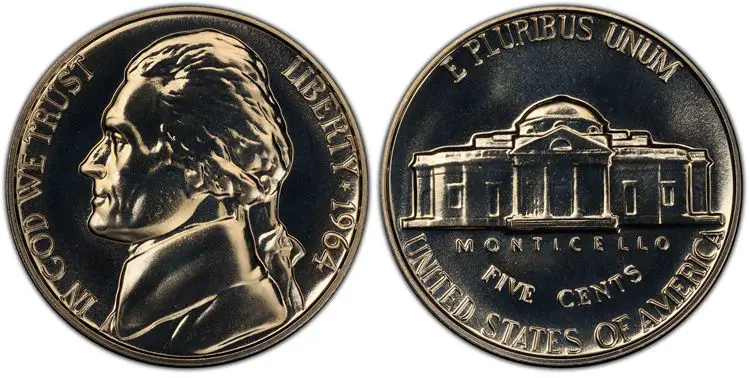
1964 Nickel Errors
There is a unique error on the Jefferson nickel that greatly increases the coin’s value. The Jefferson coin has on the reverse the Latin inscription ” E PLURIBUS UNUM.” However, there are some coins where the letter ‘B’ in the inscription appears to be the letter ‘D’. This is due to the heavy polishing that wiped off the letter.
Another error is the 1964 Jefferson Nickel struck on a copper planchet. As with the previous error, it also significantly increases the coin’s value.
How Rare is the 1964 Nickel?
As was already mentioned, the 1964- D nickel has the highest mintage in the entire series till date, and this makes it the most common 1964 nickel in circulation. However, there are others which may be harder or rarer to find.
For example, there are coins with a defect that came as a result of heavy polishing. This defect changed the letter B in the Latin inscription E Pluribus Unum (which translates to “out of many, one”) to appear to have the letter D, i.e., “PLURIDUS.” Ironically, coins with this unique error are of very high value.
Another rare coin, and probably the rarest Jefferson Nickel coin, is The 1964 SMS (Special Mint Set). This coin was minted as part of the effort to prevent collectors from causing the supposed shortage.
It has an extraordinary fine strike and a rather impressive appearance. It is worth $8,750 in MS 65.
1964 Nickel Value
As we mentioned already, a 1964 nickel is worth 5 cents in circulated condition. However, if you’re lucky enough to get a rare or Uncirculated/mint condition coin, you can sell it off for as much as $250. The rarest of them all, the 1964 SMS variant, can even be worth $8,750 with an MS65 grade.
If you’re going the pawn shop route, the Jefferson nickels attract a value of 5 cents to 0.50 cents in circulated conditions and $0.27-$8.91 or more in uncirculated conditions.
If you have an MS Jefferson nickel certified by a professional, it may be worth $43 at an online auction.
Here is a table showing how much the 1964 nickel has been sold for on eBay during an online auction:
1964 D Jefferson Nickel
Coin |
Price |
MS 63 with copper planchet error |
$350 |
MS 64 |
$5.99 |
MS 65 |
|
MS 66 |
|
MS 67 |
1964 Jefferson Nickel
Coin |
Price |
MS 64 (Rainbow Toning) |
$169.95 |
MS 65 |
|
MS 66 |
Proofs
Coin |
Price |
PR 66 |
|
PR 67 |
|
PR 68 |
$6.66 |
PR 69 |
Factors that influence the coin’s value
A coin can either increase in value or decrease due to the following factors:
- Rarity
- Mint condition
- Mint mark
In the case of rarity, this is a special mark, feature or even a defect that the coin might possess that sets it apart from other coins.
This feature might be specific to the mint it was produced.
The mint condition or Grading condition of a coin determines the quality of the coin by analyzing some key parts of the coin’s surface. Grading a coin determines the level of wear (or lack of) the coin might have experienced since it was initially minted.
While the mintmark determines what mint factory produced the coin. Coins that are minted in the United States were either produced in Denver (D), Philadelphia (P/ no mint mark) or San Francisco (S).
Grading
Grading a coin involves analyzing and inspecting the coin’s surface to determine its condition and quality.
Inspecting some key points on the coin (in this case, Thomas Jefferson’s bust) helps you assess the amount of wear the coin has been subjected to over the years. Depending on the degree of wear, the coin can be categorized into; mint, extremely fine, and lower grades(e.g fine and good)
Demand
There is a demand for the 1964 nickel which would have increased its value if not for the coin’s high mintage and availability.
Either as an addition to a collection or to complete a series. That notwithstanding, getting one wouldn’t cost you much, especially if you plan on getting it in uncirculated condition.
Best Places to Buy or Sell Your 1964 Nickel
If you’re interested in adding a 1964 Jefferson nickel to your collection, or maybe you have one, and you’d like to get it off your hands, then you’re in luck as there are several places you can acquire one or sell it off.
The most common and popular option is on online platforms like eBay, Heritage Auctions, or Etsy. Online auctions are regularly held on these platforms, and from there, they can be sold to the highest bidder. This is probably the most profitable way to sell off your coin.
Another option is your local pawn shop. You can’t go wrong with the classics. If you’re lucky, your pawn shop dealer can also help you grade your coin and give you a good deal for it. It’s a quicker alternative to online bids.
Wrapping Up
At this point, you must have deduced for yourself what exactly the 1964 Jefferson nickel is worth and why it’s so unique.
It’s worthy of any collection for its history alone, and having one in your possession should give you bragging rights. Regarding the value, that’s for you to analyze yourself to see what it’s worth.

Johannes Schreuder
Thursday 22nd of February 2024
Hi there I have a 1964 penny it is a error coin. I would like to no what is the selling price for it. Where can i get the price and where can i sell it?
James Martin
Tuesday 5th of September 2023
I have a good collection of some older coins and I would like to find out if they are worth any money. Would anybody be interested in finding out if a cost is worth looking at.
Antonio
Tuesday 20th of June 2023
Hi, how are you doing? I have a 1965 nickel. I was wondering how much is it worth?
Eduardo a. Limosinero. Jr
Tuesday 11th of April 2023
i have 1964 d penny and i want sell it..
Misnacy Win
Sunday 12th of February 2023
I have 1964 5 cent